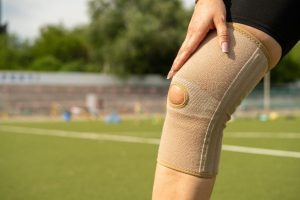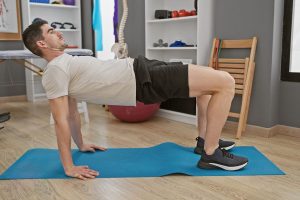When it comes to building back up ligament strength after an injury, or building tendon strength for increased injury resilience, there’s a definite process to follow and a time-frame to expect. If you’ve been wondering how long it takes to build tendon strength, this article will address your questions.
In short:
The timeline for building tendon and ligament strength varies among individuals but typically involves noticeable improvements within a few weeks to months with consistent training. Initial adaptation occurs in 4-6 weeks, intermediate progress spans 3-6 months, and long-term development extends beyond 6 months.
In this guide, we’ll explore the factors influencing the time it takes to strengthen these vital connective tissues, discuss how long it takes to build back up ligament and tendon strength, and offer practical strategies to expedite the process.
Understanding tendons and ligaments
Before delving into the timeframe for building tendon and ligament strength, we’d like to discuss the difference between tendons and ligaments.
Tendons connect muscles to bones, facilitating movement, while ligaments connect bones to bones, providing joint stability. Both play an important role in supporting the musculoskeletal system, which is what we, as physical therapists, are focused on building in order to facilitate a pain-free and functional life.
Tendons, ligaments and muscles build at different rates
While most of us understand, on a surface level, that connective tissue takes longer to build than muscle, we’d like to put some time frames on it as well as address the question as to whether tendons and ligaments grow at different rates.
The answer is that it depends on the individual joint being discussed and the exercise options available for that joint.
The main thing to know about building tendons and ligaments is that it simply takes longer than it does to build strength in muscular tissue. While it’s possible to see changes to the muscle bellies after just a few days of proper strength training with appropriate intensity, tendons and ligaments will take much longer – up to a few weeks before seeing structural changes.
The reason for this is that there is a much more limited blood supply to the connective tissue than to the muscles. Connective tissue is extremely strong, and is not designed to stretch and contract the way muscles contract and stretch. A tendon or ligament injury can be a very quick rehab if it’s caught early, or it can take many months if the issue has become chronic.
How long to build back up ligament strength from injury?
The timeline for increasing tendon and ligament strength is not one-size-fits-all (we’ll discuss more about individual factors later in this article). Just like we discussed in our article on how long it takes to improve flexibility, there are numerous factors that influence the actual answer.
However, you can expect to notice improvements over a period of several weeks to months, with more substantial gains occurring over time.
Initial adaptation (4-6 weeks)
During the initial phase of training, your body adapts to the increased demands on the tendons and ligaments. This period is crucial for laying the foundation for further strength development.
If you’re injured, we recommend sticking to light exercises focusing on the eccentric (lowering) portion of the movements during this time, focusing on utilizing a full range of motion rather than utilizing heavy resistance.
Intermediate progress (3-6 months)
As you continue to train consistently, you’ll likely experience more noticeable improvements in tendon and ligament strength. This phase is characterized by increased resilience and reduced risk of injury.
Long-term development (6 months and beyond)
Achieving optimal tendon and ligament strength is an ongoing process. Long-term commitment to a well-rounded training program will contribute to lasting improvements and better overall joint health.
At this point, it can be advisable to introduce some limited plyometric exercises to your routine in order to facilitate further growth of these very tough tissues. One note: if you’re not familiar with programming your own exercise routines, it is advisable to have a physical therapist (or even a knowledgeable personal trainer) coach you on these movements, as well as program the volume and progression for you. Plyometric exercises can be very beneficial, but can also easily be overdone.
Strategies for building tendon and ligament strength
Gradual progression
Avoid sudden increases in intensity and volume. Gradually progress in terms of weight, repetitions, and complexity to allow your connective tissues to adapt.
Include eccentric movements
As mentioned above, eccentric exercises, where the muscle lengthens under tension, are effective in targeting tendons and ligaments. Examples include eccentric squats and Nordic curls.
Though every movement you perform in the gym or physical therapy office will include some type of eccentric action, there are some exercises which emphasize this portion more, and there are also methods of removing the concentric (raising) portion of a lift or movement altogether, such that the eccentric portion of the movement is the only portion performed.
Cross-training
Engage in a variety of activities, including strength training, flexibility exercises, and low-impact activities like swimming. This diversification helps in promoting overall joint health.
If you’re not someone who sees yourself going to the gym or carving out daily time for exercise, then you may benefit from simple additions to your routine, such as daily 10-minute walks and 3-5 minute micro-workouts throughout the day.
For more ideas on how to include these types of workouts into your routine, check our micro-workout series of posts: our core micro workout, our lower body micro-workout, and our upper body micro-workout.
Proper Warm-Up and Cool Down
Prioritize warm-up and cool down in your workout routine. Dynamic stretching and mobility exercises prepare the joints and reduce the risk of injury, as well as build your mobility and flexibility over time.
Factors influencing tendon and ligament strength:
Individual variability
The time it takes to build tendon and ligament strength varies from person to person. Factors such as genetics, age, and existing fitness levels can influence the rate of progress.
Consistency and frequency
Regular, consistent training is key to strengthening tendons and ligaments. Gradually increasing the frequency and intensity of exercises helps stimulate the adaptation of these connective tissues.
Working with a professional can greatly help with this, as lack of consistency is one of the most common culprits when patients complain that physical therapy doesn’t work.
Exercise selection
Certain exercises, such as resistance training using compound movements, are more effective in promoting tendon and ligament strength generally throughout the body.
However, utilizing very specific isolation exercises, such as those a physical therapist would prescribe, can speed up your process by targeting the connective tissue in question.
Including a variety of movements in your routine can target different areas and enhance overall resilience.
Nutrition, hydration, and sleep
Though it’s been harped on ad nauseum, adequate nutrition and hydration are essential facilitators of tissue repair and growth. Protein, in particular, plays a crucial role in supporting the development of connective tissues.
Though a proper nutrition plan is best, many people can get similar results by simply prioritizing protein intake in their diets, making sure not to overeat, and getting enough sleep during their physical therapy process.
As an aside, maintaining a healthy body weight is a very good strategy to maintaining healthy joints, as you won’t be beating up your joints unnecessarily. Nutrition and sleep, in particular, are very effective strategies to obtain and maintain a healthy body weight.
In conclusion
Building tendon and ligament strength is a gradual healing process that requires consistency, patience, and a well-rounded approach to training. To keep them healthy, be sure to continue resistance training after the initial bout of recovery.
While individual timelines may vary, focusing on progressive and diverse exercises, proper nutrition, and staying hydrated will contribute to long-term improvements.
Remember, the journey to robust connective tissues is as important as the destination, so embrace the process and enjoy the benefits of enhanced joint health and resilience.

















